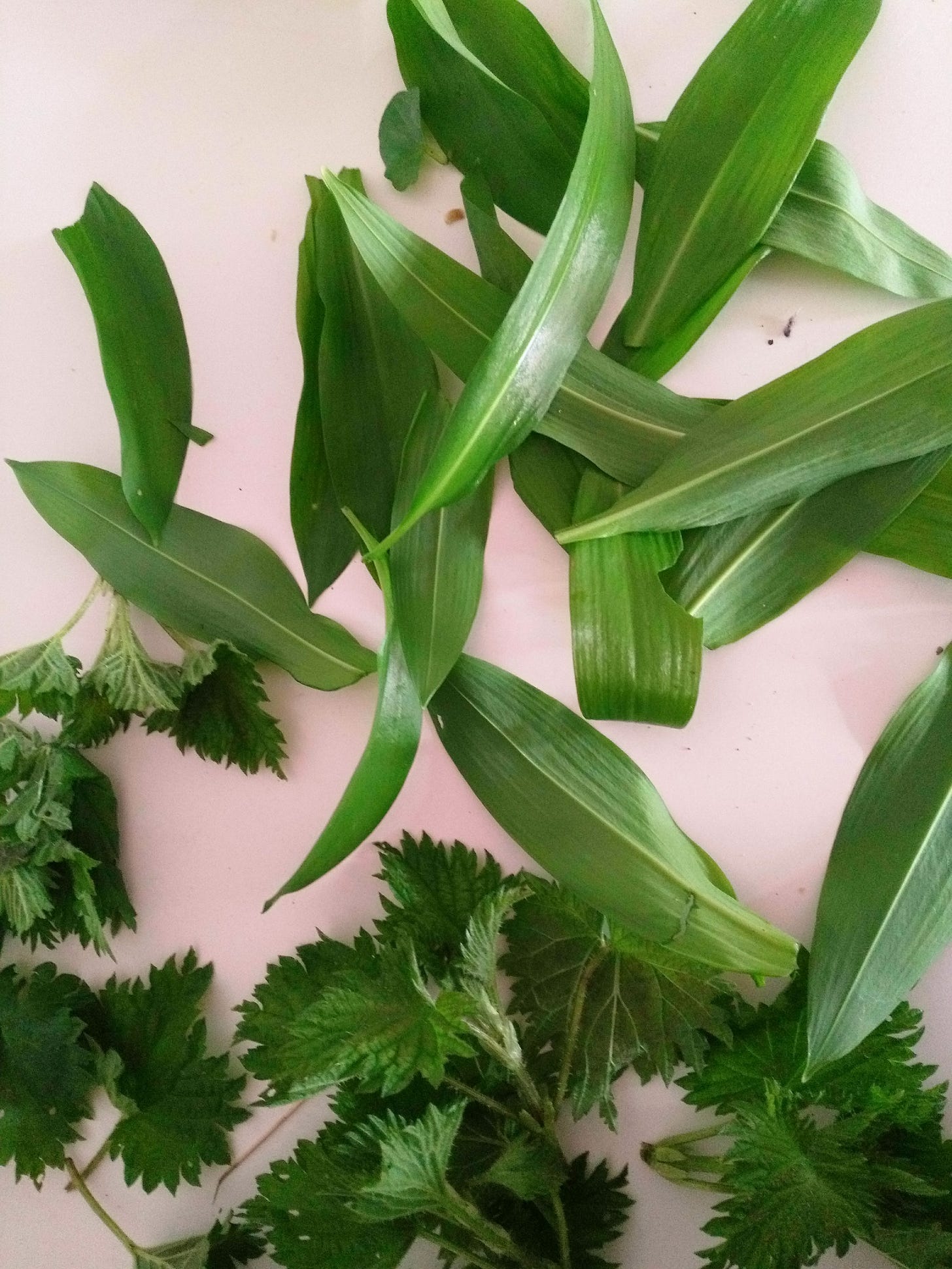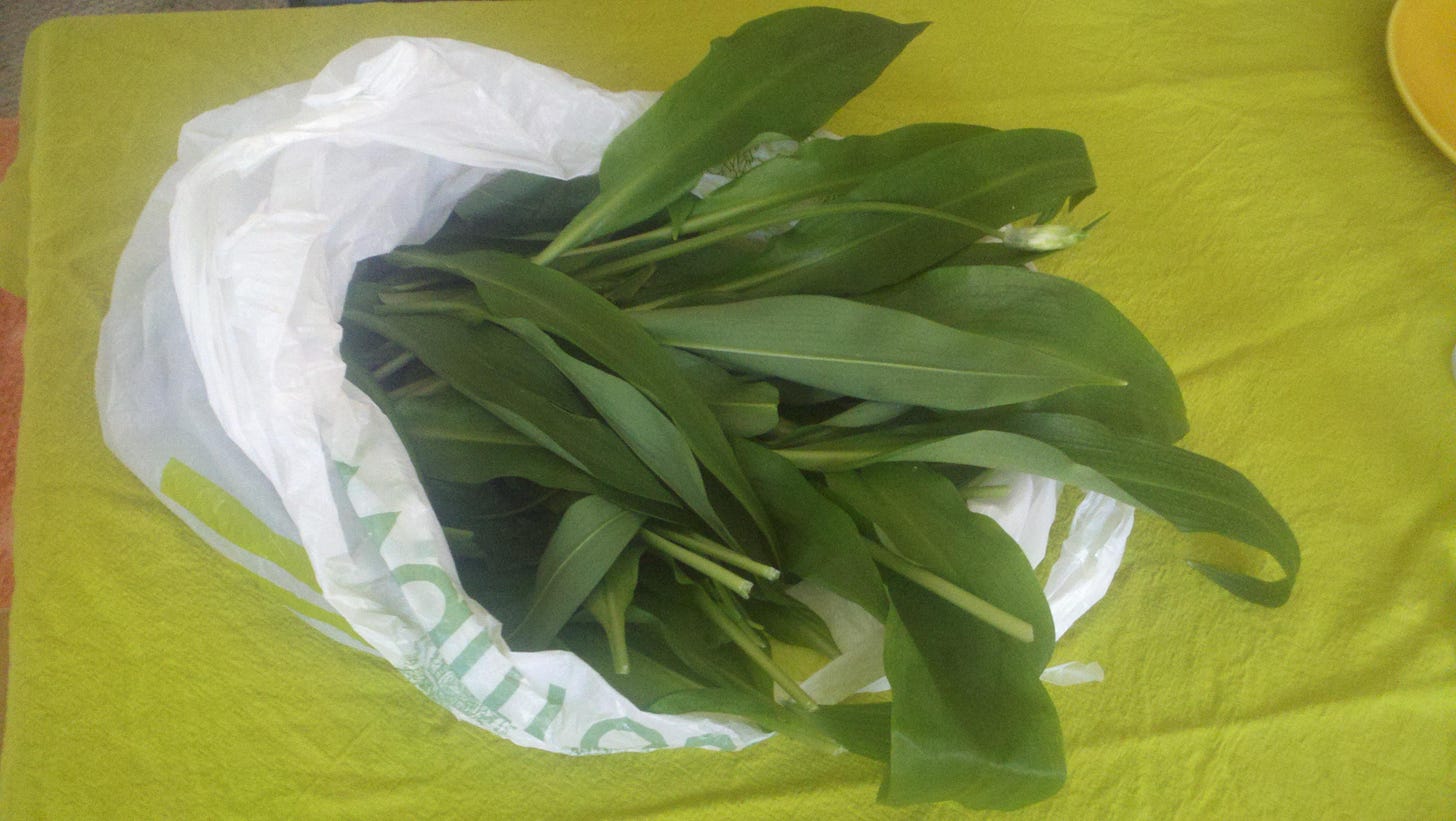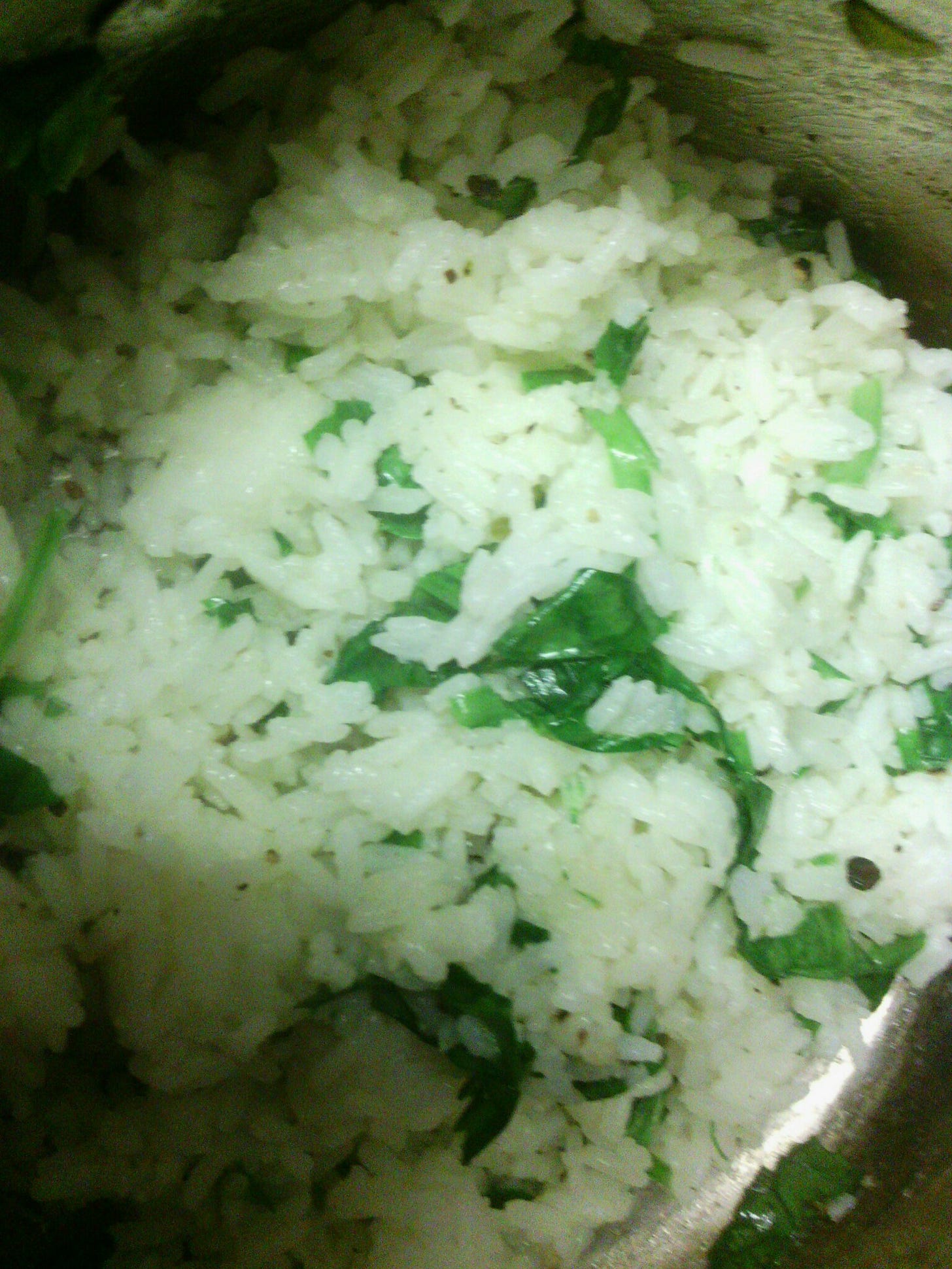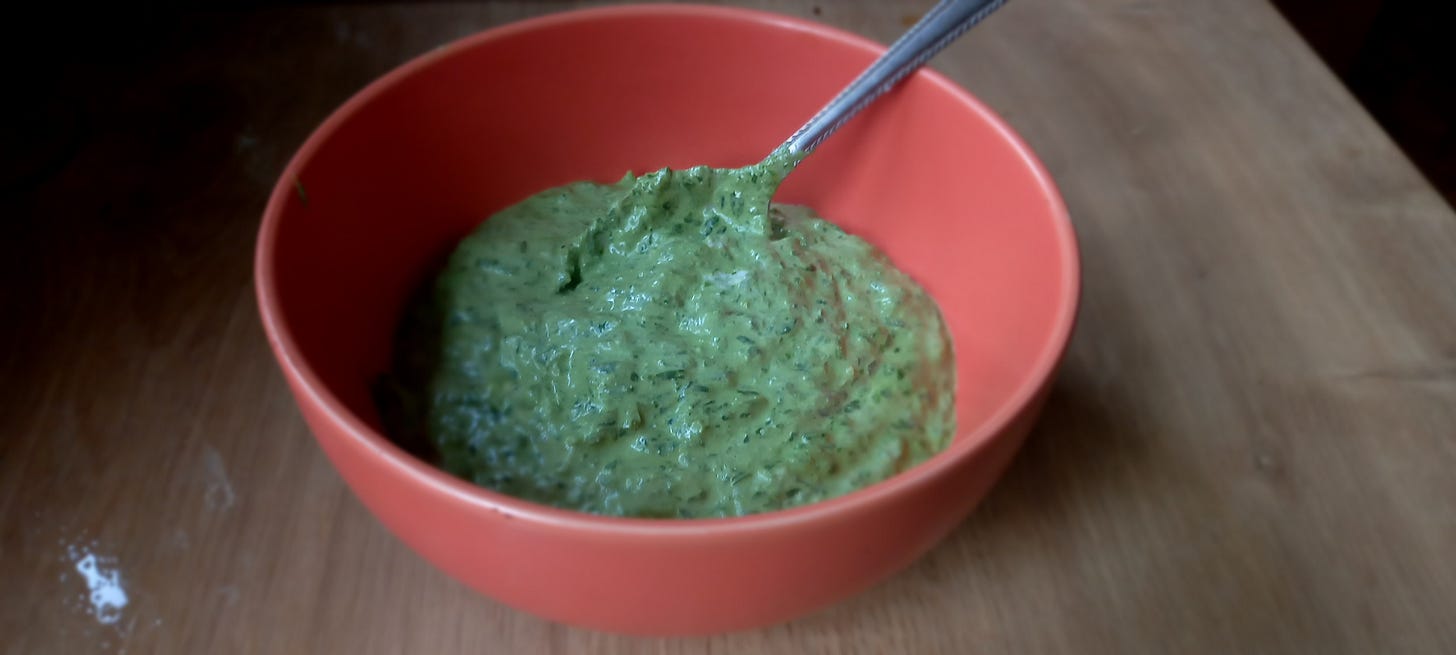The photo above is from my recent forest forage: masses of wild garlic, with young nettles in the bottom of the picture. I had gone out searching for wild garlic, but when I found a handful of patch of young nettles, I couldn’t resist plopping them into my bag as well.
Winter weather this year—meh. More than meh: I had begun to wonder if the relentless rains and sleet and winds and freezing temperatures would simply last forever. Spring seemed like a dream. A hallucination. Reality was grey and wet, windy and oh so cold!
But, look: there are a few rays of sunlight peeking through the clouds today, and the weather bureau promised even more tomorrow. The trees are sprouting buds, and everywhere I look, flowers are blossoming. The forest paths and fields were mud only a few weeks ago—are now covered in a veil of green. And, if you are lucky, Mother Nature might be readying a delicious little gift for you: wild garlic. [Wild garlic grows best in damp, wooden areas, where the sunlight filters almost dreamlike through the newly-lush springtime leaves of the trees.]
Wild garlic is mentioned in the Bible, in Greek and Latin texts from Classical times, and closer to home, evidence claims that wild garlic has been eaten by the Celtic Brits for the last 1,500 years.
My Scots married-into family (so Celtic they were Gaelic speakers) called it by [one of] its English name, wild garlic; in Hampshire, UK, where I live, it is known as ramsons, while in the USA they are called ramps. In France and Germany its l'ail des ours and barlauch. respectively, both translations meaning: Bear Garlic. The Latin term, Allium Ursinum, means the same thing: Bear Garlic. One county over from where I live, in Devon, UK, they are called Cows Leeks, because the cows love them too, and one country over from that is Cornwall, home to not only the pasty but to Cornish Yarg, a delicious cheese flavoured with the garlicky wild leaves.
Though all of the different “wild garlics” they look very much the same, and smell/taste very similar, they are not all, in fact, all the same at all. Some are not even close relatives; related to the leek and chives rather than garlic, though all are alliums.
Where do the bears come in? Apparently, bears love the shiny, smelly, leaves; waking from their winter hibernation, the bears sniff at the garlicky scent in the air, and make their way to a leafy wild garlic patch for a fresh wake-up breakfast. I mean: who doesn’t love garlic for breakfast?.
[I realize that many, perhaps most, don’t. But I do, emphatically (raw onions, too), to the disgust of many, even sometimes myself] [ Note: pan con tomate (pa amb tomàquet) is said to be Spain’s favourite breakfast: a clove or two of garlic rubbed generously onto crunchy, rustic, toast, then ripe tomatoes, finally olive oil. A whole country sharing my garlicky breakfast love!.
Before I knowingly, as an adult, tasted wild garlic, I had had this feeling of eating something familiar, sometimes leafy, sometimes sludgey, always garlicky. Maybe I even foraged it?. Was it in the Galilee, a million years ago when I lived a somewhat hippie existence in Rosh Pina and went foraging with Juliette de Bairacli Levy, at the time a world renowned animal herbalist? Or was it even earlier? Was it in the backwoods of Oregon, an area that is now a wine producing area, but at the time quite rural and rustic. I was being an artist, learning from the local hippies how to forage and from the local red-necks how to keep cows away from the garlic and how to grow basil.
Perhaps it was even earlier, when I was a child and one of the elderly synagogue ladies of the last generation, from “Europe” (said in a hushed, serious, heartbreaking tone) shared this treasure with me, as they often did with foods that were, to them, a miracle and which the new American children weren’t interested in. Was it on Kibbutz where I lived with a group of French young people who took me along sometimes as we hit the fields for wild things (and brought a basket of eggs from the hen house, to cook with the wild food over an open fire). Was it in Berkeley, when and where I cooked (and learned from) a steady stream of amazing people (including the poet Allen Ginsberg, though I have to confess that he didn’t make it to my fondue brunch as I had gotten arrested on my way home from the cheeseshop that morning, which is a whole other story, and yes I won the lawsuit for wrongful arrest (it was during a riot, I was simply a cheese shopper in the street when rounded up.
Anyhow, I had in my head this vague off and on again memory of leafy green garlicky stuff. It was so unspecific that I figured I’d never realize what I even was thinking about or remembering. And then I went to Alsace, France.
As we wandered around, in a little town, name unknown or unremembered, we came across a small marketplace. Making my way from stall to stall, past the brightly painted hand-carved toy animals (which I bought for my then-new grandson), the fruits and vegetables, herbs and jams, the cheeses and sausages, I suddenly stopped in my tracks, and sniffed the air. Somewhat like a bear might.
And there it was: that mysterious memory of garlic and green and springtime. I was standing in front of a stand selling jars of wild garlic pesto, and they were giving out free samples. A tiny crisp toast was handed to me; spread with something very green. And garlicky. And very familiar.
I do apologize if I am sounding trite, because yes, it was an epiphany, it was a Proust “Madeline moment”, but it really was. And it was profound: at first bite yes yes yes I was transported, for wont of a better description, but more than that: chewing it thoughtfully, it was almost as it the taste made me remember who I was. Until that moment, I’d had no idea that I felt incomplete; but happily chewing up the wild garlic puree on toast, I felt reclaimed. Amplified. Whole. And then, I had to buy a ridiculous number of garlic-filled jars, concerned as I was that I might never find it again.
Aren’t I silly. After I looked up wild garlic I realized that the forest behind our house was filled with it.
And, though you should always have the guidance of a forager when gathering anything, the internet has photos to help: graceful, leaves that are wide, oblong and pointy, glossy and coloured deep, yet bright, green. Halfway through the season, delicate white flowers start to appear. Wild garlic is not hard to recognize: before you even see the leaves, you'll sniff garlicky-oniony scented air. Here though is a stern warning: if it doesn’t smell like garlic, leave it behind. Wild garlic looks a lot like the highly poisonous lily of the valley; the flowers are slightly different, though both are small and white. The most tell tale differentiating characteristic is the smell.
If you’ve lost your sense of smell, due to Covid, another infection, or a head injury, you’ll need to be real careful here. Bring someone else along for the smell.
Here is how the season goes: early, when the shoots are still small and tender, their garlicky taste is subtle and grassy. As the season progresses, it grows stronger and more fiercer. Towards the end of the season they can be very strong; the flowers appear, and that's pretty much it for the rest of the year. Start to finish, its about two months from gathering the first delicate shoots to wiping your mouth after the last garlicky meal. Though it always seems to me like a short season, everything I have read says: “Oh, its one of the longer seasons of ripening and edible-ness”.
Now that you have your wild garlic patch, what do you do with your foraging? Many e--especially in North America--pickle the bulbs. I can understand it but caution against: wild green garlic grows from a rhizome under the earth, connected by a bulb. The base stays in the earth, connecting to the roots of the shoots, producing year after year, spreading goodness throughout its area. If the underground growing system is disturbed, though, you could find that next year: no ramps! no bear garlic!
The Indigenous North American Tribes knew this--and by the way, one of the tribal names for wild garlic is Chicagaoua, and if I am not mistaken, i is, in fact, and this is SO EXCITING, the word that the city of Chicago is named after, there was so much wild garlic growing in the area. Native Cherokees harvested only the leaves out of respect to the whole growing cycle of the plants. America’s country-dwelling elders who descended from Europeans have learned and continue this practice. Alas there are those who are greedy and dig up whole plants; many sell them at"farmers markets" for prices more akin to a jewelry shop than a food market. This way of harvesting devastates the patch it grows in, and can endanger the whole wild garlic growing area.
So: snip rather than tug at the leaves and the garlic patch should flourish.
And yet: some disagree. I have a feeling that it probably has to do with exactly what kind of wild garlic we are speaking about.
At the start of wild garlic season, when it is still rare and precious, I gather a bag full and bring it into my kitchen where I daydream about what to make with it. I add it with great joy to...practically everything. I snip and I snip and I snip each time I head into the forest, and return with filled up carrier bags to share as gifts.
The leaves stay fresh for days and days, up to about 2 weeks, rinsed, dried, and stashed it in the refrigerator. Surprisingly the leaves freeze well, though you will need to use it cooked rather than raw, as is the case with freezing all leafy vegetables and herbs.
This is when the first pesto gets put up, half stashed in the freezer for the future, and half to be eaten fresh, on past or salads, stirred into risotto or soup, scrambled into omelets, or mixed into creamy buttery mashed potatoes. Wild garlic butter also: just blitz the wild garlic with unsalted butter adding salt to taste. Good spread on hot toasted crumpets, baked potatoes, or spooned into big mushroom caps and roasted.
A handful of wild garlic makes everything taste so…Springlike! Delightful too combined with other springtime vegetables such as asparagus, young favas, artichokes, baby zucchini and/or young peas. Or all of them, all at once! Once I saw a “chilled wild garlic and nettle soup” on a restaurant menu in the Swedish town of Orebro; how I regret not getting it! I could be one more recipe towards dealing with my prolific garlic garlic springtime.
The Russians pickle the stems; so do the Greeks, though the Greeks also bake wild garlic with other greens and feta, as well as make a lovely salad of leaves and stems, “dressed with local olive oil, homemade vinegar, and sea salt gathered yourself if possible.”
And if you’re thinking about making matzo balls, may I suggest chopping or slicing a big handful or two thinly, and adding them to the matzo meal mixture before forming the balls and poaching. Even my husband, not so well know for a love of matzo balls or a love of wild garlic, absolutely LOVED the combination of the two. At our Pesach seder he kept muttering in awe, almost like his very own version of “The Four Questions”: why are these matzo balls different from all other matzo balls? Unlike the ritual answers, my answer was very simple: “its got wild garlic in it”.
By the Middle of the season it is easy to take wild garlic for granted: you always have this stash of garlicky greens on hand, and if you run out, they're simply a trot away into the forest to gather more.
By now its wild garlic for nearly every meal. Tossing it into spaghetti aglio olio instead of parsley, steaping a handful of the leaves into a jar of vodka for Bloody Marys and fermenting a crock of kimchee (radish and wild garlic) which, by the way, is absolutely luscious with hummus and pita.
One day I used the garlicky greens to wrap bite sized pieces of grilled pork, with a dab of a hoisin dipping sauce. Next time I’m going to try rolling the garlic leaf wrapped morsel into a soaked and softened Vietnamese rice paper to make a salad roll). Yesterday I mixed wild garlic with soft cheese (aka cream cheese), spread it thickly on a toasted bagel.
Toward the end of the season, though, after all of the excited anticipation, the diligent monitoring of the garlic patch, you reach a point where its all over. Your garlicky love affair. You probably can’t even give it away now, as your friends are no doubt a bit overdosed on it as well.
Then, if you’re like me, you'll go onto Social Media crying out for ideas to use the wild garlic only to find a whole community out there wailing in unison. Everyone is in a panic: What to do with wild garlic next? The horror of wasting it and not taking full delight in its season is real.
You trade suggestions and recipes anyway, because someone else's idea is new to you. And there is still a lot of wild garlic growing in the forest. And your freezer is getting full.
Sometimes I get an idea that turns out not so great--such adding it to tzadziki, since I had great luck with wild purslane tzadziki. It was only so-so. And using wild garlic leaves as a base to steam bao or baozi (Chinese buns) on was not the brilliant idea I thought it would be.
When I added the wild garlic leaves to red lentil soup instead of spinach, it was marvellous! Added to Greek and Middle Eastern spinach or other leafy green pies, it was also wonderful. And if you're roasting a chicken, stuff a handful inside, it will give fragrant moisture to the chicken as it cooks.
I like them chopped and added to egg salad, or tuna salad, or Hidden Valley type buttermilk or yogurt dressings, and tucked into a Pan Bagnat.
At the moment, we are about 2/3 of the way through the wild garlic cycle, and I’m foraging a bit obsessively, getting a little nervous about taking full advantage of my forest garlic wealth. I know I’ll miss them when the season is over.
About the nettles in the photo above? Nettles are great. Snip off only the top three leaves. Use gloves, Blanch before using. That is all, except for the fact that they are very healthy, good in soup, fillings, and my favourite, kneaded into fresh pasta. You can freeze them too, though with all that wild garlic in your freezer, is there really room?
Which reminds me: would you like a nice bag of wild garlic? Its fresh, oh so fresh, and the forest is only a few steps away from our house. And I’m always ready to pick some for you.
Udon Miso Soup with Wild Garlic Meatballs
Serves 4
If you prefer noodles such as those used for ramen, use those in place of the fat, squidgy, udon (which I adore).
Also if you are awash with wild garlic, and really want a garlicky hit, add a handful to the soup as well as adding it to the meatballs.
Meatballs:
250g lamb mince
1 teaspoon or to taste, dark soy sauce, or as desired
1/2 teaspoon sesame oil, or more as desired
1/2 teaspoon grated fresh ginger or a pinch dried
Handful ramps/wild garlic, coarsely chopped
2 heaped tablespoon raw couscous or fine bulgar
1 egg
Pinch each: salt and pepper
1 teaspoon sugar
Soup:
1.5 litres stock or bone broth
Udon (since it usually comes in individual portions, allow 4)
3 heaped tablespoons white miso
Combine all of the meatball ingredients; mix well and form large meatballs.
Brown the meatballs on a pan they are hopefully not going to stick to; take care they don't fall apart. When they are cooked through, and firmish to the touch, set aside while you make the soup.
Heat the stock or bone broth, then reduce heat and simmer while you cook the udon.
Boil the udon until just tender then rinse gently in cool water.
Mix the miso with a few tablespoons of the soup to thin it down to keep it from leaving salty lumps in the soup.
Add the thinned miso to the soup, warm through until it slightly thickens add the wild garlic if using. Into each bowl place a meatball, a portion of udon, and ladle in the hot soup. Eat right away.
Wild Garlic (Ramps) Rice (above)
Serves 4.
This dish is all about the tender soothing rice, fragrant wild garlic, and rich, melting butter.
200g long or shortgrain rice, as desired
500ml water
Several BIG handfuls of wild garlic
3-4 tablespoons butter, less or more as you like.
Rinse and soak the rice. Bring to the boil, reduce heat and cook, covered, for about 7 minutes. Turn off heat and let it sit about 10 minutes to plump up. I use a rice cooker; it is transformative if you like steamed rice. Simple to use, and makes wonderful rice.
Thinly thinly slice the wild garlic
Toss in the wild garlic and butter, salt and pepper to taste, and cover to warm through.
Marlena’s Hampshire Rarebit
(though it is really more an open faced grilled cheese sandwich)
That is to say: shredded wild garlic and slabs of white Cheddar or other white meltable cheese, grilled/broiled/air fried on top of thickly sliced rustic whole grain bread. Since I have no photo of my rarebit, I’m going to leave you with the photo below and its mini-recipe.
Based on the Hidden Valley mix of sour cream and mayonnaise, I’ve subbed greek yogurt for the sour cream, and added about 5 cups of tightly packed wild garlic leaves (you’ll need to cut them up fairly small in order to puree/blend them). Salt and pepper to taste, and I added an extra raw garlic clove to whizz up into the mix. Its strong garlicky stuff, though it looks so pretty and pastel green.
Now, while you are reading this newsletter I am going to run around the kitchen tasting it with all sorts of things: I’ve already tried it with a chunk of poached chicken breast—yeah. And a hunk of hot crunchy baguette. Next up: boiled potatoes, green beans, macaroni, scrambled egg or omelet. I’ll report back. Before I send this newsletter out. I promise.
Hours later: Report: 1. delicious with boiled new potatoes, just a dab on top of a slightly warm very tender spud. 2. really good spread onto baguette with a layer of white Cheddar. 3. with warm freshly cooked penne, not so much. I’m waiting for it to cool to see if it would be good in a pasta and vegetable salad. Okay, its cooled. it is just FINE. In other words, meh. 4. those little boiled then smashed spuds, drizzled with olive oil then roasted/air fried/baked/fried to a brown crisp are Delish with several dabs of wild green sauce. And for the last one, at least today: OMG mash the wild garlic sauce with boiled potatoes for garlicky green mash! Hot is good, and cold is wonderful too!








Terrific post, Marlena! Thank you for this--so full of information, passion, and lovely memories! Im keeping it open to read again and again.
You told me so many interesting things, I can't even remember them all. Most likely, I will refresh my memory by coming here in the future. Udon Miso Soup with Wild Garlic Meatballs made me curious, I will definitely make it when I get a chance.